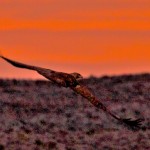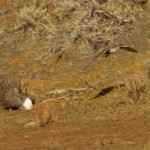Leks are predictable places to find groups of animals worried about fighting and mating and not always watching for danger. As a result, they can become targets for hungry predators looking for an easy meal. In some cases the large number of watchful eyes offers enough protection, and approaching predators are spotted early enough to give males and females a chance to flee. This is what we’ve normally seen with the sage-grouse- in most years golden eagle attacks (the main predator for adult birds on the leks) have been fairly rare in our area, and those attacks have almost never been successful.
I was fortunate enough to witness a couple of attacks last week. The first was an unsuccessful attack at Cottontail. This one was noteworthy mainly because it took place against a stunningly colorful sunrise. The urgent simultaneous take-off off the entire lek of birds alerted me to the attack, but I didn’t find the bird until it was already turned around and headed away from the lek.
The next day I was at Chugwater, and just when I started recording and Becca and Melissa had overlook cameras running, another eagle flew in. This attack ended successfully (for the eagle at least), and it was able to catch a fleeing female grouse out of the air. It perched just out of sight behind some sage and ate the whole thing minus the wings, feathers and a few guts, within maybe a quarter of an hour. Some grouse had already returned to the lek, and were not terribly happy about an eagle all of a sudden appearing from just a few tens of meters away!
On my next visit to Cottontail, we saw another attack, although I think this one was less serious for the grouse. A prairie falcon was diving at some males on the western end of the lek. The falcon was probably half the size of the grouse (especially an inflated grouse), and the harassed males mainly just fell forward on their face and vocal sacs to avoid trouble.



